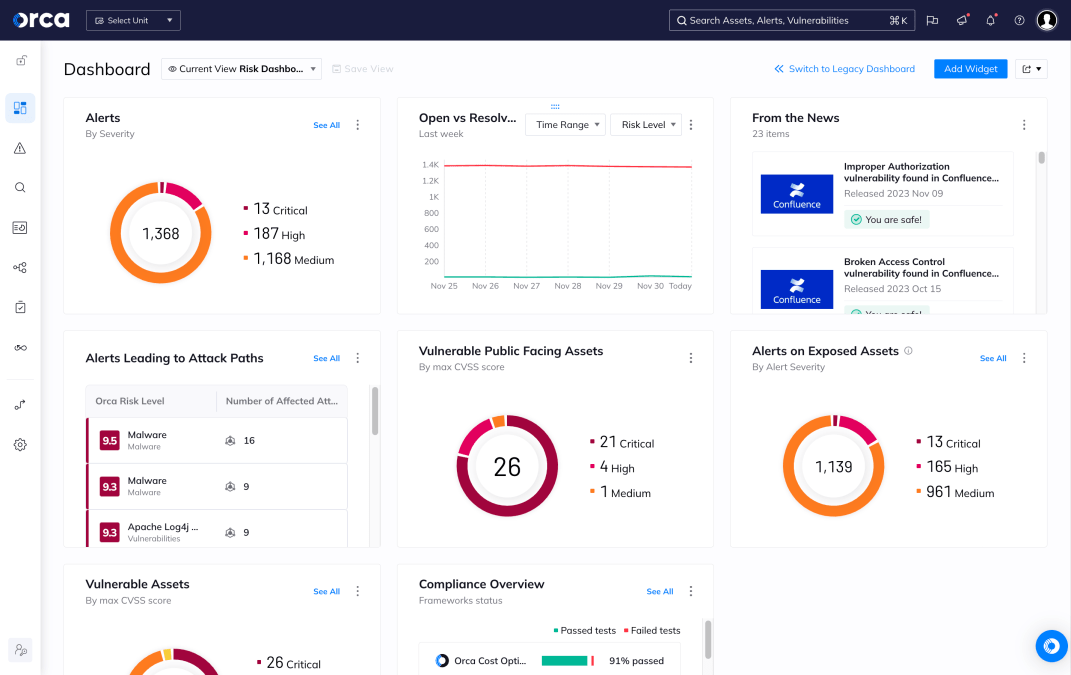Threat intelligence is the collection, analysis, and dissemination of information about current and emerging cybersecurity threats that could potentially impact an organization’s systems, data, and operations. This process transforms raw data about malicious activities, attack patterns, and adversary tactics into actionable insights that security teams can use to make informed decisions about their defensive strategies. In cloud security environments, threat intelligence becomes particularly critical as organizations face an expanded attack surface and must protect distributed workloads across multiple cloud platforms and hybrid infrastructures.
Why is it important?
Threat intelligence serves as the foundation for proactive cybersecurity defense, enabling organizations to shift from reactive incident response to predictive threat prevention. This capability is essential for cloud environments where traditional perimeter-based security models are inadequate, and security teams must understand the evolving threat landscape to protect dynamic, scalable infrastructure.
The importance of threat intelligence extends beyond technical security teams to business leadership, as it directly impacts risk management decisions, compliance requirements, and operational continuity. Organizations operating in regulated industries rely on threat intelligence to demonstrate due diligence in their security practices and to align their security investments with actual risk exposure rather than theoretical vulnerabilities.
How does it work?
Threat intelligence operates through a cyclical process known as the intelligence lifecycle, which consists of six key phases:
- Planning and direction – Define intelligence requirements based on risk profiles and threat models.
- Collection – Gather data from sources including OSINT, commercial feeds, internal telemetry, and industry sharing groups.
- Processing – Normalize, deduplicate, and correlate raw data to prepare it for analysis.
- Analysis – Provide context about threat actors, attack campaigns, and possible TTPs.
- Dissemination – Deliver tailored intelligence to security teams and business stakeholders.
- Feedback – Assess relevance and quality to refine future intelligence cycles.
In cloud environments, threat intelligence platforms integrate with SOAR tools to enrich security alerts with real-world context. This allows security teams to prioritize incidents based on validated threats rather than treating all alerts equally.
Security risks and challenges
Organizations face several challenges when implementing threat intelligence programs:
- Data overload – Security teams often struggle to process the volume of threat data, leading to alert fatigue.
- Quality and relevance – Generic threat feeds may lack value for specific technology stacks or threat models.
- Cloud-specific challenges – The complexity and pace of cloud infrastructure changes make it difficult to maintain accurate threat context.
- Attribution difficulties – Accurately identifying threat actors and motivations requires sophisticated analysis that many organizations lack.
- Integration complexity – Many legacy systems and security tools are not designed for seamless intelligence integration.
Best practices and mitigation strategies
Organizations can maximize the value of threat intelligence by implementing the following practices:
- Develop a threat model:
- Identify critical assets and potential adversaries.
- Align intelligence priorities with business risk.
- Diversify intelligence sources:
- Combine commercial feeds with government advisories, industry groups, and internal telemetry.
- Use frameworks such as MITRE ATT&CK to contextualize threats.
- Automate correlation and enrichment:
- Leverage threat intelligence platforms that integrate with SIEM and SOAR tools.
- Automate enrichment of alerts with threat context to accelerate triage and response.
- Measure program effectiveness:
- Track metrics such as mean time to detection (MTTD), threat attribution accuracy, and intelligence-driven incident resolution.
- Invest in analyst training:
- Provide training on interpreting threat intelligence and validating source credibility.
- Promote collaboration between threat analysts and incident responders.
- Ensure cloud-native compatibility:
- Select tools that understand and monitor cloud-specific configurations and services.
- Validate how threats manifest in multi-cloud and hybrid environments.
How Orca Security helps
The Orca Cloud Security Platform delivers comprehensive threat intelligence, enabling organizations to detect, prioritize, and remediate critical risks across AWS, Azure, Google Cloud, Oracle Cloud, Alibaba Cloud, and Kubernetes environments.
With Orca, security teams can:
- Gain full visibility across single- or multi-cloud environments and application pipelines, including before deployment and in runtime
- Dynamic risk prioritization that analyzes risks holistically in the context of your full cloud estate, scoring risks accurately based on severity and business impact
- Leverage real-time visibility, monitoring, detection, and prevention capabilities for sensitive cloud workloads
- Surface toxic risk combinations that endanger high-value assets with Orca’s Attack Path Analysis
- Automate workflows and integrate security findings using deep integrations with ticketing systems, source code management (SCM) applications, as well as common security tools
By delivering advanced and continuous threat intelligence, Orca enables security teams to focus on addressing their most critical risks and active threats.




